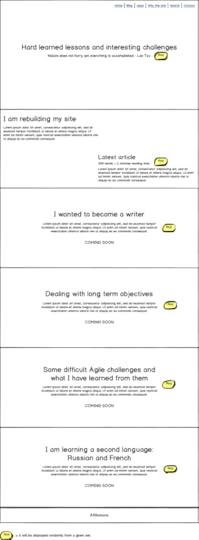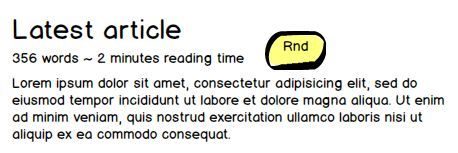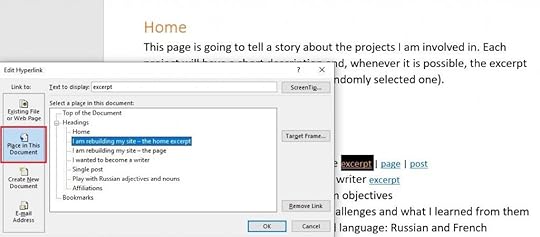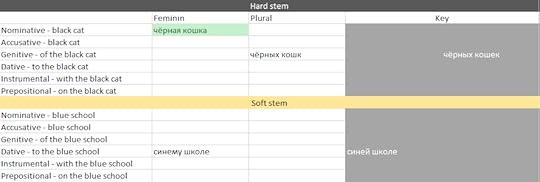Dan Rădoiu's Blog
August 8, 2021
The layout mockup
When building an app, mockups are one of the most – if not the most – useful, but at the same time, a dangerous tool. If they are properly used, they will dramatically improve your time to production and enhance the code quality. When not, the team will spend more and more time trying to make them to look like the final product. They will use everything but the kitchen sink – animations, rich user interactions, complicated color schemes – to mimic the product. It’s like an addiction. You start small, but before you know it, you went too deep, too far.
Balsamiq is a great tool to organize your initial thoughts, but, as a personal opinion, it takes you only that far. When you see those pages, you start aching to click on buttons. You can do that – Balsamiq gives you the opportunity to link pages to controls – but it’s not the real deal. You need more.
During my career as a software developer, then as a coach, I tried every mockuping (is this even a word?) product that I could lay my hands on. My goal was to achieve the feeling that the users will experience when using the real app, as fast as possible. Finally, I chose HTML and CSS as my favorite tools With just Visual Code, some decent CSS knowledge, and a reusable boilerplate, a team can build the mockup for a medium to complex app in less than three days. Yup, that’s right! Imagine going from zero to hero in just three days. Today you have nothing, just words and ideas, and by the end of the week you can interact with the app’s outer shell. Damn awesome!
When coaching a team, right after we create the very first Balsamiq mockup, we continue with the layout mockup. It’s simple to develop, fun, and it involves the whole team. We grab our laptops, go in a shared space, and start working together. I use this opportunity to brainstorm the customer journey, the flow’s usability, and how the app will behave and look on different devices. For the time being, the team feedback is recorded as simple HTML paragraphs
…
. Later on, they will be transformed into nice and unintrusive comments, but we are not there yet. Before anything else, we need to establish the layout, how the content will be structured, then presented to the final user.Links:
danradoiu.ro – the layout mockup
Resources:
June 28, 2021
The home page mockup
The dreadful moment has arrived. It’s here. I am looking at the Balsamiq window and I feel devoid of energy. All my shiny ideas are gone. All I can do is stare at this blank page:

Do I need a parallax effect? If so, what might be a relevant picture, a relevant text? Or maybe a full-page carousel would be more appropriate. Yes, but they tend to perform poorly on mobile phones, so I need to design two different versions: one for laptops and desktops, and the other for small screens.
Luckily, I am familiar with this state of mind. I have encountered it many times while writing my books. I think it’s called “the blank page syndrome”.
It happens, to me at least, when I lose my focus. When, instead of looking towards “who”, “what”, and “why”, I switch too early to “how”.
It’s going to sound idiotic, but why do I need a home page for my blog? Why not leave it blank?
We live in a very fast-paced world. When addressing someone, we have just a couple of seconds to engage their attention or to lose it. Some studies say ten to fifteen seconds. Based on my browsing habits, I would say it’s more like two to four.
This is why I should have a home page. I have two seconds to engage my reader. How should I do that? “Show them it’s about a journey!” says a little voice inside my head. “People love journeys”.
The muse is back! Suddenly, I can see the whole site, at least it’s very first version. I don’t have a logo yet, but I decide that I can live without it for now:

I like it. When scrolling, it tells a story about the things I do. The excerpts, besides being appetizers, offer an important piece of information: how long it will take to read that article:

That was nice. It took me something like 40 minutes to make the mockup in Balsamiq, the defogging time included. Now, because I can see it, I can feel how it flows from the reader’s perspective. It’s something that, at least in my opinion, every product owner should be able to do. It has nothing to do with “IT” or programming, but with the ability to visualize the product. Using Balsamiq, Draw.io or any other tool of this kind, is no more complicated than making a presentation in PowerPoint.
June 21, 2021
The conceptual mockup
Allegedly, a picture is worth a thousand words. It’s true, but you know what is worth a million words (sure, besides a thousand pictures)? The ability to enter the picture, to play with its content.
Even before I started coaching teams to work in an Agile manner, I had a thing. You may call it curiosity. I would call it obsession. Like some alchemists before me, I was searching for a Philosopher’s Stone. I didn’t want gold – Bitcoin might have been trendier – but the ability to turn an idea, no matter how foggy it was, in an immediately implementable product. Yeah, when you put it like that, the gold version starts looking achievable by comparison.
I haven’t found it yet, but along the way I understood that while buttons, actions, animations are important, the actual content trumps them every time. In order to create a link, you need to have a “click here” piece of text:
Coach: What information will be displayed on this page?
Product Owner: The annual profit and loss structure. And when you click on a category –
Coach: Besides the profit and loss structure, what else?
Product Owner: Hmmm, the aggregated figures for the last three years would be nice too. And when you select one of the previous years, then it expands and –
Coach: And what else besides the aggregated figures?
Product Owner: That’s an interesting question. Now that you’ve asked, I think that […] would be a nice addition too. It will definitely enhance the added business value of this product!
In fewer words:
while(what_else() != “”) keep_asking_what_else();
There are a lot of specialized mock-up tools on the market, I know, but for the early stages of a product, I prefer using Microsoft Word. It works with hyperlinks and this is all I need for the moment.
The process of building a conceptual mockup is simple. First, I write the page name and I make it Heading 1. Then, I write a short description about whatever it’s going be there. It doesn’t need to be a brilliant piece of literature. Poor grammar and bad spelling are welcome. Most of the time this material will be discarded as you advance to the next level: a low-fidelity visual mockup. When what_else() returns false, I start linking together the information I have uncovered. This is the moment when making the page titles Heading 1 pays off. You can easily reference them:

The name of the game for this phase is: “As fast as possible!”. Don’t insert tables, even if you see them in your mind. Just list the columns, adding meaningful explanations as you go. If you can grab a screenshot instead of entering some text, do it without thinking twice. Remember? As fast as possible!
As a personal experience, for a medium-complexity product, I usually finish the conceptual mockup in less than an hour.
You can find the complete conceptual mockup of this site here: docx and pdf.
June 20, 2021
Planning and priorities
When it comes to reaching objectives, there are two kinds of people: those who make plans and those who actually reach them. Most of the time, who does one, doesn’t do the other.
That’s a bold and maybe a controversial statement. We need someone to contest it. Let me introduce to you a well-known Romanian character: Mr. Gică Contra!
Gică is a diminutive from George. “Contra” means against. Combined, they mean ” Gică Who Is Always Opposing”. You can – and you will – meet this guy especially during the technical meetings. He is the one who has a problem for each and every solution.
Let’s invite him to temporarily take the floor.
“How can you say that?” explodes Mr. Gică Contra, immediately taking the opportunity. “It’s preposterous! A plan helps you reach your destination. Without one, there is no journey, just an aimless series of movements!”
Actually, no. What does that is the act of continuously planning, finding the next best move in an everchanging context. Adapt and survive.
The words of military generals are an interesting thing. They tend to provide a tried-and-true approach, as they belong to the winning side. The others, usually don’t get quoted the history books:
Plans are nothing. Planning is everything
Dwight Eisenhower
and
A good plan, violently executed now, is better than a perfect plan next week
George Patton
It makes sense. The more time you spend planning, the less time you have for the actions you must take in order to achieve your goal.
It took me a while, but I discovered that knowing just the next two actions I need to take, puts me in control. It helps me fight procrastination – what do you do when you are not prepared yet to do something? A plan – and at the same time to avoid “paralysis by analysis”, a toxic situation when you finally have the plan, but no energy to left to see it to fruition.
Going back to my site, the next two things I need to do are:
Draw a Balsamiq mockup for the home and the post page.Set up my working environment.Normally, setting up the environment should be first, but somehow, I don’t feel so. Perhaps my brain needs to see, from a visual point of view, where it needs to go. I’ll leave it this way.
June 16, 2021
Going Live
It happened! Ladies and gentlemen, we are live! All the (necessary) ports are opened. Domozină, m-auzi?1
So, I gathered all my courage and I pressed the button. Between us, there were a lot of buttons to push in order to make the change, but it sounds more literary this way. A high stake and a smart villain would have been nice too, but more on this subject in a future series.
While I was adding articles to the site, I saw that the latest ones were shown first. Not good. At least in this moment, I see my blog as a collection of series, which means older posts should be displayed first (FIFO). Seeing the last episode of Games of Thrones before the one where “the winter is coming”, would be less entertaining to say the least. But WordPress didn’t get the memo, so by default it displays the latest articles first.
I found how to change this behavior here:
https://www.wpbeginner.com/plugins/reorder-wordpress-posts-using-drag-drop/
Long story short, I installed a plugin – Code Snippets – and I added copy-and-paste a piece of code.
It’s an interesting feeling. Suddenly, I feel the urge to finish it. Next post is going to be about planning and priorities.
 Fun fact
Fun factDomozină, can you hear me? That’s something a Romanian might say when checking a possible unreliable communication channel; most probable, a landline phone.
Sebastian Domozină was a well-known sports commentator renowned for his unique style and his fast-paced commentaries. During the communist era, electronic equipment used by the state-owned radio service was not of the best quality. Sometimes it stopped working right in a middle of a hot moment. Imagine the commentator speaking faster and faster, the tension building up to the high heavens, then… nothing. Just silence. After a second or two, the unsure voice of the guy from the studio would be heard: Domozină, can you hear me?
June 3, 2021
Taking an Agile approach
This was one of those times when being the coach, and the client too, has paid off extremely well. When I have heard myself enumerating all those questions for which I did not have an answer yet, I felt immersed in a very deep state of desperation:
In order to have a decent site, I need to be able to design one. I know a couple of things about modern trends, but not enough. More study is required – at least two or three courses about web design, web development, usability, and very important, how to choose a good color scheme (you may laugh; I know I did it when I heard myself).Then I need to be able to build a WordPress theme from scratch, so I need to learn that too.Then I need to find some good pictures for the home page and for the articles. That’s even more wicked. What looks relevant today, becomes out of tune and dull the next time when I look at them! What should I do?I could have asked a professional web designer to build me one, but, as an Agile Coach, I have learned that bringing a technical expert does not help when the product vision is still unclear.
It was an interesting case. I am an Agile Coach. Helping people solving this kind of challenges is how I earn my living. Was I acting like an Agile practitioner? Definitely not, and that was something that needed to change immediately:
Coach: Dan, how would you change your approach if this project would be a professional, not a personal one? Let’s say it belongs to one of your teams that you are currently coaching. What would you do differently?
Client: Now that you mentioned it…
There was something in my speech that grabbed my attention: instead of placing my focus on the content – the bread and butter of a blog – I was focusing mainly on the outer shell. I was building a very customized face for some data which I didn’t have. Best case scenario, I was heading for a great deal of rework.
Romanians have a saying: “Să faci ce zice popa, nu ce face popa” – do what the priest says, not what he does. I remember coaching product owners and teams to go live as fast as possible, with just a Minimal Viable Product, but it’s not as easy as it looks, is it? You know that you can do it better, and having people interacting with a thing that looks only half baked, hurts your feelings. “Let’s wait another sprint. Let’s make the MVP just a little bit better” becomes the word of the day. Before you know it, “as fast as possible” becomes “already too late”. Not good.
So, I decided to use my own advice. I am going to archive the old site, install WordPress from scratch on my domain, and then I will start writing all the articles which are happily zooming in my mind, asking to go out.
The next articles in this category will be notes and scribbles from the trenches: challenges, solutions, lessons learned. Wish me luck. I am going in!
June 2, 2021
Searching for energy
In a previous post, I was the coach, and at the same time, the client. A bit of schizophrenia, if you ask, but for me, it worked perfectly.
Being able to access the coaching toolbox, to feel how a coaching question impacts my client’s feelings, his thoughts too, has been proven to be invaluable since I started my coaching practice. As Pinocchio had his Jiminy cricket, wherever I go, I carry the coaching voice with me. One hundred years ago, they would have locked me away for “hearing voices”. Today, a thing like that might even look cool! And you can get rid of your Spotify subscription too.
Going back to our client. There was a major dissonance in his speech. Did you spot it?
Coach: With your permission, I would like to go back to the need of rebuilding your site. You told me that it usually appeared whenever you were learning something new. Can you give me an example?
Client (eyes sparkling): Oh, yeah! I can give you the last one. As I was trying to memorize the declinations for the Russian adjectives, I realized that I could transform the Excel file I was using into a very nice product, a tool that might be used by other people as well.
Coach (making a neutral face): An Excel file?
Client: Yes, this one. If you get it right, the cell becomes green. If not, it displays the correct answer in the grey area. Just imagine what a specialized product might do! To be able to play with thousands of similar combinations.

The coach smiles, then moves in for the kill. Can you say what is he going to do next?
June 1, 2021
Warming up the engines
Ok, this one was long overdue. Rebuilding my site has been on my to do list since forever. No matter how many times I tried to do it, I failed. It was the only project that I have continuously postponed in the last ten years or so.
Something needed to change, so I took a coaching approach. I coached myself.
How do you help a client to break the pattern? As always, you cannot solve it if you don’t see it. First, you help them to see that pattern.
Coach: Dan, help me with a piece of information, please. How many times did you try to build your site?
Client: I don’t know, man. I lost count of them. Perhaps six, but it could have been as much as ten times. Ten frigging times.
In a real-world situation, I would have kept helping my client deploy his thoughts for a while, but for the sake of simplicity, in this post I will cut to the chase and go directly for the kill:
Coach: Can you recall the context of your attempts? How did they unfold?
Client: It was almost the same every time. While I was doing something – usually learning something new – I had an idea about a product, a web page or a mobile app, which could help me and others a lot. Where to put it? Sure, on my site.
Coach: And your site was…?
Client (exploding): Not ready at the moment to receive the product. If I had wanted that product, I would have had to rebuild it.
Coach: What kept you back? You are a developer, why did you not simply rebuild your site?
Client (making a miserable face): I am a developer, that’s right, but do you know how many things you have to put into a site? Let me tell you, with bullet points, what I did not know, and I still don’t:
What needs to be on the front page? A parallax effect? And what pictures would be representative for:Agile and professional coaching,software development,writing,the books I read, games I play, the hobbies I have?Should I use it as a commercial tool? Should I give it a suit-and-tie look or should I go for a more casual appearance?What should I place in the site’s footer? I have no idea what needs to go there. The sites I have studied for inspiration have a lot of shiny things there!Coach (scratching his head): Wow, that’s a lot…
Let’s play a game. What would be your next question to the Client if you were the Coach? He wants to rebuild his site, but the uncertainties he has hinders him in achieving his goal.
March 24, 2016
Analiza tranzacțională utilizată în coachingul profesionist
O sesiune de coaching profesionist este ca o partidă de tenis de masă. Replicile clientului și intervențiile coach-ului se succed rapid, nelăsându-i celui din urmă prea mult timp pentru a identifica acea întrebare (sau moment de tăcere, de ce nu) care să-l ajute pe client să pășească în afara cadrului de referință actual (și probabil limitativ). E util să ai la îndemână o modalitate de a îngusta spațiul intervențiilor adecvate în respectivul context.
Analiza tranzacțională poate fi una dintre aceste modalități. Pentru cei ce nu au auzit despre această teorie a personalității umane, la sfârșitul articolului voi include câteva cărți care pe mine m-au ajutat să înțeleg – atât cât am izbutit s-o fac :) – acest domeniu fascinant.
Să ne aducem aminte de structura eu-ului așa cum a fost ea descrisă de Eric Berne:

Părinte = acel strat al personalității care știe că “așa se face”, indiferent că este vorba despre opritul la culoarea roșie a semaforului sau despre faptul că până la vârsta “corespunzătoare” copii sunt făcuți pentru a fi văzuți, nu auziți.
Adult = gândirea analitică branșată la realitatea curentă. Prin intermediul acestui strat al personalității, învățăm să folosim un aparat cu butoane sau explicăm cuiva cum să ajungă la o adresă anume.
Copil = starea Eu-lui care resimte emoțiile și care a învățat cum să dea curs într-un mod ok nevoilor interioare. Din acest strat visăm la un corn cu ciocolată, râdem cu poftă (chiar dacă este cel mai nepotrivit moment cu putință) sau facem cu ochiul unei persoane care ne-a trezit interesul.
Dacă tot am menționat mai sus cornul cu ciocolată, o posibilă situație care ar angrena toate cele trei stări ale Eu-ului ar arăta cam așa:
Pfff, ce bine arată cornurile acelea cu ciocolată. Am să îmi iau unul chiar acum! [Copil]
– Nu vă supărați, sunt proaspete cornurile? [Adult]
– Azi ni le-au adus [Adult].
Cumpărătorul arată către unul glazurat; ochii îi râd. Apoi, brusc, își amintește o regulă de comportament “elementar”: O persoană educată nu clefăie pe stradă; mâncarea se mănâncă acasă. [Părinte]
– Ăăă, lăsați. M-am răzgândit, spune el, lăsând privirea în pământ.
– E de la greutate, nu? rânjește vânzătorul, aruncând înapoi în vitrină cornul cu ciocolată.
Ultimele două tranzacții, deși aparent sunt purtate tot în registrul de Adult, reprezintă schimburi complexe. Prima este o tranzacție duplex (în plan social cumpărătorul spune “Ăăă, lăsați. M-am răzgândit”, în timp ce în plan psihologic (printre rânduri, adică) gesturile lui lasă să se înțeleagă “Of, îmi pare rău; chiar mi-aș fi luat unul” – Adult/Copil Adaptat.
A doua tranzacție este chiar și mai interesantă decât prima, deoarece reprezintă o ambivalență asumată (o tranzacție unghiulară). În timp ce cuvintele sunt ale Adultului (aparent vânzătorul solicită o informație), ea este o răzbunare mascată, pedepsindu-l pe cumpărător pentru inconsecvența lui “Cam plesnesc pantalonii pe matale, nu-i așa? Vezi că e unul de repară pantofi vreo sută de metri mai încolo. Roagă-l să-ți ajusteze cureaua”.
În continuare am să mă refer la o analiză structurală mai complexă – programatorul din mine nu rezistă să nu o numească “advanced”; presimt că am să ard în iadul rezervat agresorilor limbii române. Voi așeza pe orizontală straturile Eu-ului (fapt pentru care am să ard și în iadul celor ce îndrăznesc să se atingă de modelul PAC, așa cum a fost el figurat inițial).
Dacă ne gândim la talerele unei balanțe, în mijloc aflându-se gândirea centrată pe “aici-și-acum” [Adult], iar stânga-dreapta, aspectul învățat al vieții [Părinte] și cel simțit [Copil], obținem:

În continuare, dacă privim stratul de Părinte ca o sumă a regulilor internalizate (cum să oprești la semafor, dar și cum să ai grijă de cei din jur), iar pe cel de Copil ca pe deținătorul emoțiilor și al modalităților (ok) de adaptare la regulile sociale, avem:

Iar când fiecare dintre aceste stări funcționează în exces (asta și gata, trecem la legătura dintre AT și coaching), situația devine:

Interesante sunt monezile de schimb ale fiecărei stări ale eului:
Părintele Normativ este sensibil la referințe către regulamente și legi. Se declară mulțumit atunci când interlocutorul se “adaptează”, urmând regulile în cauză.
Părintele Critic, în schimb, nu se mulțumește cu atât, vrea ca interlocutorul lui să se simtă mizerabil, să “plătească” pentru greșeala de a fi încălcat respectivele reglementări.
Părintele Binevoitor are grijă de ceilalți, cultivând în ei independența. Este mulțumit când celorlalți le este bine.
Părintele Salvator, din contră, ia asupra lui sarcinile tuturor celor pe care îi are în “grijă”. În cele din urmă eșuează din cauza volumului prea mare de muncă, victimizându-se cu această ocazie. Este fericit când ceilalți “nu pot fără el”.
Adultul tranzacționează fapte, informații seci. Dacă unui Adult îi spui că un anumit articol este scump, el te va întreba: “Scump în comparație cu ce?”.
Copilul Adaptat este cel care se oprește la semafor și care nu atinge întrerupătorul cu mâinile ude (deși nu mai există de mult acele instalații electrice de care străbunicul lui se temea). Este satisfăcut când există predictibilitate în actul de adaptare: acum fac “ce trebuie”, apoi mă lași în pace. Se supune, dar nu se lasă călcat în picioare.
Copilul Obedient, din contră, este un Copil Adaptat care se supra-adaptează. Este satisfăcut atunci când găsește un Părinte Critic care să-l oprime.
Copilul Liber râde tare, merge cu viteză (tricicletă sau mașină decapotabilă, nu contează), iar dacă nu ar fi Copilul Adaptat care să-l determine să-și pună pantalonii pe el atunci când iese afară, le-ar face o surpriză celor de pe stradă. Tranzacționează sentimente exprimate liber, dragoste cu sclipici, dar la fel de bine și supărare cu farfurii zburătoare (nu extraterestre, ci pământene, existente în dulapul cu veselă).
Copilul Rebel se comportă așa cum îi zice numele: se revoltă și este furios, fiind în manifestări aproape identic cu Părintele Critic, deosebirea fiind că el se apără, în timp ce Părintele Critic atacă. Este mulțumit atunci când reușește să îndepărteze amenințarea care l-a determinat să își facă simțită prezența.
În continuare, vă propun să ne gândim împreună cum am putea folosi preferințele fiecăreia dintre stările “roșii” – Părintele Critic, Copilul Obedient, Părintele Salvator și Copilul Rebel – în timpul unei sesiuni de coaching.
Părintele Critic
Să presupunem că avem un client care funcționează în starea de Părinte Critic, exprimându-se în termeni foarte elocvenți la adresa guvernanților și al minorităților de tot felul etc. Care a fi o intervenție de coaching potrivită? Dacă îl întrebăm:
“Cum te gândești să abordezi această dificultate?”, cel mai probabil am primi un răspuns coerent cu Părintele Critic:
“Nu este treaba mea să abordez ceva. Să se ocupe guvernul, că de aia plătesc impozite!”
În schimb – iar aici vine beneficiul îmbinării elementelor de analiza tranzacțională cu cele de coaching – am putea face apel la partea ok a stării de Părinte – mai exact la cea de Părinte Normativ – a cărui monedă favorită sunt regulile și reglementările:
“Ce principiu din tine vorbește acum?”
Și deși există o mie de moduri în care lucrurile pot merge prost punând această întrebare, de cele mai multe ori oamenilor le vine greu să pună un comportament ne-ok alături de un principiu de viață (care se presupune că este prin esență bun și înalt). De aici se poate continua mai departe.
Copilul Obedient
Să presupunem că unul dintre clienții noștri menționează des în timpul sesiunii de coaching expresii ca “nu știu”, “nu pot”, “n-am cum”, “nu-mi este permis” etc., expresii potențial coerente cu starea de Copil Obedient (dar nu neapărat). Într-o astfel de situație, chiar și o strategie de segmentare a problemei în pași mici are mari șanse să fie refuzată:
“Care ar fi cel mai mic pas care te-ar îndrepta în direcția potrivită?”
“Nu știu”
Apelând la elementele analizei tranzacționale și intuind un Copil Adaptat care funcționează în exces, putem face apel la partea ok acestei stări – adaptabilitatea. În aceste condiții, deși prezintă un oarecare grad de risc, aș opta pentru o strategie care ar conține un factor negativ:
Care sunt trei calități pe care oamenii nu le văd în mod constant la tine?
sau
Care sunt trei defecte pe care oamenii le remarcă cel mai adesea la tine? (riscant, dar poate fi o abordare de efect; unui client cu poziționare de victimă îi va veni mai simplu să enumere defecte decât calități)
Apoi, prin echilibrare și comparație:
Dacă acestea sunt defectele pe care ceilalți le văd cel mai des la tine, care sunt calitățile care le contrabalansează?
Iar de aici se poate continua, unind dificultatea care constituie contractul de coaching cu respectivele calități.
Părintele Salvator
Să spunem că unul dintre clienții noștri acuză oboseală cronică, muncă în exces, “eu sunt unul, ei o mie”, fără să manifeste și o înclinație evidentă de a ieși din această stare. Motivul recurent este “nu are altcineva cine să le facă”.
Dacă poziționarea clientului nostru este într-adevăr una de Părinte Salvator (ceea ce nu este obligatoriu, chiar în condițiile date; foarte bine poate fi vorba de o persoană care chiar nu are încotro!), atunci avem un Părinte Binevoitor care îi ajută pe cei din jur mai mult decât ar trebui s-o facă. Această grija autentică poate constitui un bun punct de pornire:
Cu ce plătesc cei de care ai grijă pentru bula de siguranță cu care îi înconjori?
Și din nou, de aici se poate lucra.
Copilul Rebel
Să presupunem că un client are un discurs agresiv orientat către protecția personală: “Atâta îi trebuie, să-mi zică așa ceva; să vezi ce au să-i mai audă urechile ” sau “N-ai să vezi! Îi rup o mână și un picior și-l bat cu ele peste cap” – Copilul Rebel (ca și celelalte nuanțe de Copil) crede în magie, bună sau rea. Are impresia că este suficient să folosească expresii agresive pentru ca inamicul să arunce armele și să părăsească în dezordine câmpul de luptă. Știind acest lucru, am putea adresa exact nevoia care a determinat apariția Copilului Rebel:
Care este acel element pe care îl percepi ca fiind de nesuportat în situația în care te afli?
Atenție însă la un aspect: este posibil ca o întrebare de acest fel să atragă după sine apariția Părintelui Critic, a cărui prezență va necesita un apel la reguli și reglementări.
Cam atât despre analiza tranzacțională folosită în coaching-ul profesionist. Din punctul meu de vedere, ea poate fi un instrument util atâta timp cât nu uităm că o sesiune de coaching reprezintă un spațiu la dispoziția clientului și nu o scenă pentru coach de a-și demonstra abilitățile personale; că o mie de strategii aduse “de-a gata” de acasă nu fac cât o acompaniere care se desfășoară în spiritul coaching-ului profesionist.
Iată și materialele despre care aminteam la începutul articolului:
O scurtă introducere în analiză tranzacțională. Nu foarte bine explicată în zonele avansate, dar îmi aduc aminte că n-am putut s-o las din mână; a fost prima carte de AT pe care am citit-o: http://www.elefant.ro/carti/carti-de-specialitate/stiinte-umaniste/psihologie/analiza-tranzactionala-155132.html
De la distanță, favorita mea. Foarte bine explicate conceptele de scenariu de viață, cupoane psihologice (cât și interpretarea din punct de vedere tranzacționalist a basmului Scufița Roșie. Urmărindu-l pe Berne, ajungi la concluzia că lupul ar fi marele perdant în toată afacerea): http://www.edituratrei.ro/product.php/Eric_Berne_Ce_spui_dup%C4_Bun%C4_ziua_Psihologia_destinului_uman/1983/
Și din nou ceva de Eric Berne, “Jocurile noastre de toate zilele. Psihologia relațiilor umane” (prima dată a fost tradusă ca “Jocuri pentru adulți”. Nu-mi vine să mă gândesc la câte retururi a avut editura din partea cititorilor, hm, înfuriați de jocurile intitulate “Dacă n-ai fi fost tu” sau “Picior de lemn” când probabil că aspirațiile lor că erau altele, având în vedere titlul): http://www.edituratrei.ro/carte/eric-berne-jocurile-noastre-de-toate-zilele-psihologia-relatiilor-umane/2665/
Apoi, o carte scrisă Claude Steiner, discipolul favorit al lui Berne. Am citit-o cu regret că se termină: http://www.amazon.com/Scripts-People-Live-Transactional-Analysis/dp/0802132103 – și tot de el puteți să aruncați o privire printr-una dintre povestirile lui cu tâlc, “A warm fuzzy tale”. O găsiți în română aici: http://www.claudesteiner.com/fuzzyrom.htm
“Born to Win”, o carte excelentă despre scenariile de viață. Atenție la primul capitol care este scris în cel mai american mod cu putință; puteți să treceți peste el direct. Pierderea va fi insesizabilă: http://www.amazon.com/Born-Win-Transactional-Analysis-Experiments/dp/0201590441
Iar în încheiere, cel mai bun material de AT care mi-a căzut în mână. Așa cum spuneam într-un alt articol, dacă aflați cine este autorul (este un român), vă rog să îmi spuneți și mie. Mi-aș dori să-i pot mulțumi în mod personal: http://www.scribd.com/doc/185429473/0008-ANALIZA-TRANZACTIONALA
.eu-state {text-align: right; border-bottom: 2px solid dimgray; font-weight: bold; }
March 24, 2015
Lansări Crux Publishing
Cum târgul de carte Final Frontier se apropie, vă invit pe 28 martie în Nexus Club & Bar în București pentru a cunoaște trei autori români de fantasy senzaționali, ale căror volume le veți citi pe nerăsuflate!
Primul pare coborât de pe același raft cu Poe și Lovecraft, al doilea vine cu elemente eriksoniene împletite în intrigi complexe despre fanatism religios, corupție și libertate, iar cel de-al treilea (citând din descrierea evenimentului) “vă face să alunecați din realitate în fantezie” ;) cât ați zice… Final Frontier!
Ceasul fantasmelor, Oliviu Crâznic
Dacă vreți să citiți:
…despre un răzbunător rănit şi despre o fată cu trandafir în păr, care îşi doarme somnul de veci sub gheaţă;
…despre un preot răpit în toiul nopţii de doi bărbaţi misterioşi şi forţat să îngrijească rănile unei tinere ferecate în lanţuri;
…despre o seducătoare stranie vizitând un fort izolat, din care soldaţii dispar unul câte unul;
…despre o trecătoare dacă, în care rămăşiţele unei legiuni romane înfruntă o ameninţare supranaturală;
…despre doi poliţişti care răspund unui apel obişnuit, doar pentru a a-şi întâmpina destinul într-o casă a tragediei;
…despre trei adolescenţi care întâlnesc un Rău ocult în drumul lor spre maturitate;
…despre o necunoscută moartă şi despre cât de departe pot merge autorităţile pentru a da de urma criminalului;
…despre un anchetator obosit şi confuz, urmărind un criminal nebun într-o lume aflată la capătul Timpului;
…despre cum poate fi prevenită asasinarea femeii iubite, atunci când toate previziunile sfârşesc la fel;
…şi despre preafrumoasa Ermengaarde din Dinastia Eyes, a cărei inteligenţă cântată de barzi a transformat farmecul feminin în armă supremă,
…dar și despre multe altele, Crux Publishing vă invită de la ora 15.45 să stați de vorbă cu Oliviu Crâznic – autor român premiat național și internațional, cunoscut și ca ”momentul Walpole în literatura română”. Alături de autor și de Prof. Florin Corneliu Pîtea veți participa la dezvăluirea secretelor acestui volum care se citește cel mai bine noaptea, cu lumina aprinsă!
Anotimpul pumnalelor, Șerban Andrei Mazilu
Începând cu ora 16.00, veți putea discuta despre romanul dark fantasy Anotimpul pumnalelor, semnat de Șerban Andrei Mazilu, tânărul autor care a debutat în Statele Unite și care acum își face intrarea pe piața românească de fantasy cu un roman clockpunk excepțional.
Așa cum spune și Ștefan Bolea, (Dr. în Filosofie, Drd. în Litere)
”Creând un cuplu de ucigaşi iniţiaţi, care mixează moartea şi iubirea cu revoluţia, ce rivalizează cu cele din Matrix şi Neuromancer – dar şi cu manifestul We Will Rise al celor de la Arch Enemy –, Şerban Andrei Mazilu surprinde din nou (după debutul său american) cu o distopie dark fantasy post-modernă luxuriantă şi exotică. Ce se întâmplă când umbrele iau foc? Dincolo de religie – mai este loc de spiritualitate? Ne putem clădi universul în jurul lui Destrudo? Există un singur zeu, spune un personaj, Thanos (după personificarea grecească a morţii) şi noi toţi ardem pe altarul său!”
Personaje complexe, intrigi și jocuri politice dureros de apropiate de lumea noastră contemporană, confruntări pe viață și pe moarte, ideologii și dogme, atacuri sângeroase și iubiri fragile, toate se desfășoară explosiv într-un univers fantastic încărcat de mister.
Împreună cu Crux Publishing veți desluși enigmele propuse de autor și înțelege coordonatele literare ale romanului împreună cu Oliviu Crâznic și alți invitați.
Povestiri de la marginea realității, Dan Rădoiu, yours truly
Din nou, din descrierea evenimentului: “Seria de lansări încheia se va cu o propunere amuzantă și destul de excentrică: de la ora 16.15 vă invităm să ”alunecați” din realitate în fantezie alături de Dan Rădoiu, un scriitor ce combină umorul cu bizarul, fantasticul cu banalul și viața cu suprarealismul pentru a ne conduce dincolo de vălul realității, în lumea lui personală, populată de întâmplări și personaje dintre cele mai neobișnuite.”
Nici eu nu puteam sa o zic mai bine.
Vă veți întâlni cu:
… un soț criminal obsedat de misterul unui șifonier, care descoperă, printre altele, și puterea de a vindeca,
… un strigoi blestemat să își trăiască veșnicia în metroul bucureștean, pornit fiind să facă schimb de soartă (și de trup) cu o victimă neștiutoare,
… ceainicul zeiței Hecate, făcător de minuni dintre cele mai imprevizibile, cu adânci consecințe pentru viitorul social și politic al întregii omeniri
… un duh al lămpii, alcoolic, încăpățânat și captiv în puterea unui băiețel ce are o singură dorință,
… un cuplu menit să își trăiască povestea de iubire într-un timp aflat în afara timpului,
… ghemotoace de hârtie care ucid, pelicani bombardieri sau căluți de lemn scoși la plimbare în lesă, un instalator cel puțin bizar, o domnișoară plecată la întâlnire cu moartea (fizică? spirituală?), o statuie de lemn care fură prăjituri, precum și multe, multe altele.
Și din nou: “Lumea lui Dan Rădoiu, aflată la o ciudată intersecție între melancolia lui Mircea Eliade și suprarealismul lui David Lynch, abia așteaptă să fie descoperită pas cu pas! Ghidul pentru această călătorie în universuri aparent banale, dar magice – dacă știi cum să le privești, va fi Eugen Cadaru, autorul volumului A opta zi e-n fiecare noapte”
Ne vedem la Nexus Club & Bar în București (Bvd. Regina Elisabeta nr. 37), sâmbătă 28 martie, între orele 15.54 și 16.30 pentru a îi cunoaște pe Oliviu Crâznic, Andrei Mazilu și, ați ghicit, Dan Rădoiu!
Dan Rădoiu's Blog
- Dan Rădoiu's profile
- 10 followers



